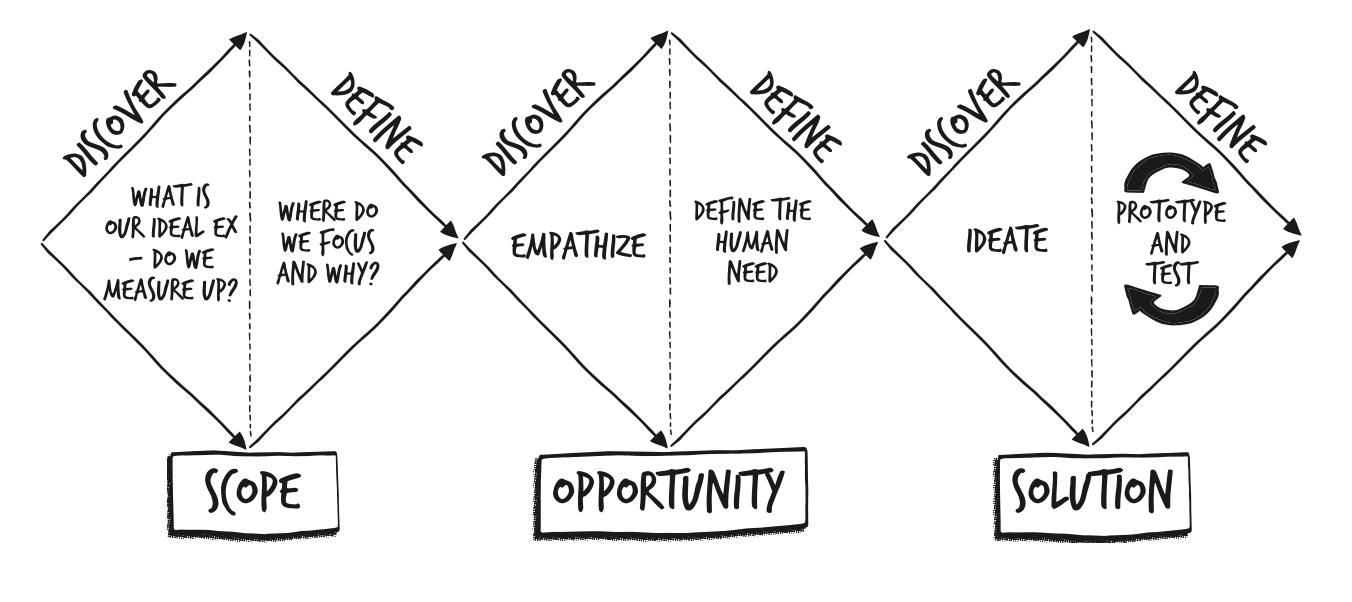What is empathy and how can it help EX Design?

Emma Bridger
Minutes
09 Mar 2023
Employee Experience
Empathy
Employee Experience Design
Empathy
Employee Experience Design
Designing brilliant experiences for our
people should involve a deep, empathic understanding of them. Personas and
empathy maps are tools we can use to help us to achieve this. But what is
empathy and how can we use it in EX design?
In summary, empathy is the ability to stand in someone else’s shoes and
see the world through their eyes. Empathy helps us to challenge preconceived
ideas, and assumptions about the employee experience.
Being empathic enables us to design and create solutions for the things that really matter to people, not the things we might think are important. For example, a company’s engagement survey suggested that recognition is an issue. In response, HR spent six months and a lot of money designing an employee of the month programme, a new platform to support it and a glittering event to celebrate winners. However, in the next engagement survey, the score has not improved. It turns out, what people really wanted was for someone to say thank you for a job well done. Taking an empathic approach to this challenge would have avoided this scenario.
Psychologists debate precise definitions of empathy. However, most agree that empathy is not one thing, but many. It is a collective noun for a range of ways people respond to other people’s feelings. Indi Young, author of Practical Empathy (2015), likens it to a roll of tools. When we unroll our kit, we have a choice about which empathy tool to pull out. That choice activates different brain systems which are useful at different times in how we connect with others.
Being empathic enables us to design and create solutions for the things that really matter to people, not the things we might think are important. For example, a company’s engagement survey suggested that recognition is an issue. In response, HR spent six months and a lot of money designing an employee of the month programme, a new platform to support it and a glittering event to celebrate winners. However, in the next engagement survey, the score has not improved. It turns out, what people really wanted was for someone to say thank you for a job well done. Taking an empathic approach to this challenge would have avoided this scenario.
Psychologists debate precise definitions of empathy. However, most agree that empathy is not one thing, but many. It is a collective noun for a range of ways people respond to other people’s feelings. Indi Young, author of Practical Empathy (2015), likens it to a roll of tools. When we unroll our kit, we have a choice about which empathy tool to pull out. That choice activates different brain systems which are useful at different times in how we connect with others.
Emotional empathy is when we take on the emotions of
others. This is really powerful in EX design, helping to fuel ideation and
create the energy to see the process through to final solutions.
Cognitive empathy helps us identify and understand other
people’s perspectives – like walking in their shoes. It helps us get to
the core needs and motivations of the people we’re designing for and
overcome our own assumptions and biases.
Empathic concern goes beyond understanding others and
sharing their feelings. It inspires us to take action. It is a useful
energy when it comes to solving problems, as well as a helpful
characteristic in leaders, managers and colleagues.
Empathy isn’t a fixed trait. In individuals, teams, and organisations,
it can be nurtured and grown much like a muscle, empathy strengthens the more
it’s put to use. This is powerful information. Simply knowing that it is
possible to build empathy can inspire individuals towards empathy, according to
Jamil Zaki, Associate Professor of Psychology at Stanford University and author
of The War for Kindness: Building Empathy in a Fractured World (2019). Additionally, we
are more likely to exercise empathy if we have a sense of belonging or
connection with another person or group – or we’re seeking to create it. This
tells us a lot about how we should be constructing and working with our mixed
EX design teams and end users – employees.
Cultures that openly value and reward empathy also help to nurture it. Some organisations are focusing on creating moments and opportunities to nurture and celebrate empathy among their teams. IDEO, for example, encourages employees to set aside time to help colleagues, and considers generosity during hiring and promotion (Amabile et al, 2014).
Many organisations have taken the recent changes in ways of working ushered in by COVID-19 as an opportunity to upskill leaders and line managers in emotional intelligence (EQ), the foundation of empathy.
Cultures that openly value and reward empathy also help to nurture it. Some organisations are focusing on creating moments and opportunities to nurture and celebrate empathy among their teams. IDEO, for example, encourages employees to set aside time to help colleagues, and considers generosity during hiring and promotion (Amabile et al, 2014).
Many organisations have taken the recent changes in ways of working ushered in by COVID-19 as an opportunity to upskill leaders and line managers in emotional intelligence (EQ), the foundation of empathy.
EQ is the ability to
identify, use, understand, and manage our emotions in positive and constructive
ways. It’s about recognising our own emotional state and the emotional states
of others. Just as empathy is not fixed, neither is our EQ: we can develop and
improve it and so develop our ability to empathise. EQ involves:
By working on our EQ, we can develop our ability to recognise emotions in others and to know what they’re feeling and why.
Empathy is of course a principle of great EX design across the whole approach, but it really gets put to work in the opportunity space – the second diamond in the EX Design framework:
- The ability to recognise and manage our emotions
- The ability to connect with others using nonverbal communication
- The ability to use humor and play to deal with challenges
- The ability to recognise emotional responses in others
- The ability to quickly reduce stress
By working on our EQ, we can develop our ability to recognise emotions in others and to know what they’re feeling and why.
Empathy is of course a principle of great EX design across the whole approach, but it really gets put to work in the opportunity space – the second diamond in the EX Design framework:

Here we work our empathy muscle to discover new information to broaden
and deepen our understanding of an issue; to uncover not only what the
problem or opportunity is, but why.
Sometimes initial understanding of an issue might come from a survey or other quantitative data indicating that something is up, for example 75% of people leaving within their first three months of joining. Or, on the other hand, you might have an ill-formed hunch about an issue and start with empathy-based discovery, going deep with a small group of people to work out where the issue lies, before then validating it with quantitative data – perhaps then going back to explore more with those affected. Whichever way you come at it, the empathy discovery process is an essential component. It means speaking to and spending time with people who are affected by the issue, not simply looking at survey and other data. Building empathy into the discovery process also helps overcome our cognitive biases and ensure a better outcome.
Sometimes initial understanding of an issue might come from a survey or other quantitative data indicating that something is up, for example 75% of people leaving within their first three months of joining. Or, on the other hand, you might have an ill-formed hunch about an issue and start with empathy-based discovery, going deep with a small group of people to work out where the issue lies, before then validating it with quantitative data – perhaps then going back to explore more with those affected. Whichever way you come at it, the empathy discovery process is an essential component. It means speaking to and spending time with people who are affected by the issue, not simply looking at survey and other data. Building empathy into the discovery process also helps overcome our cognitive biases and ensure a better outcome.

